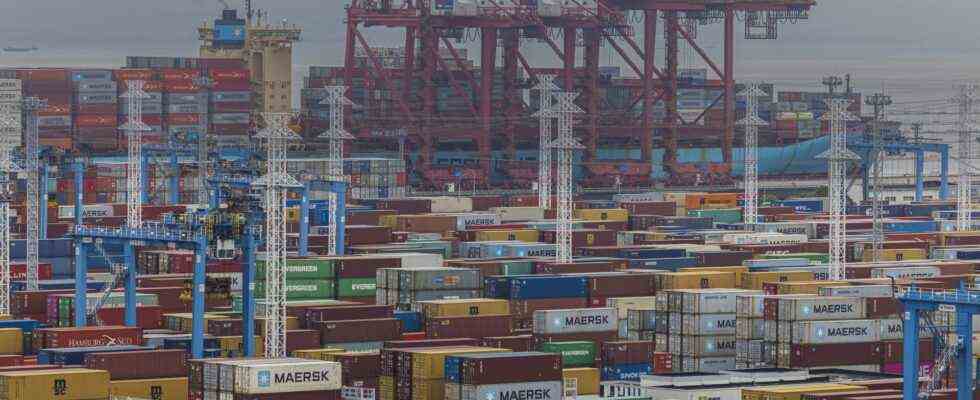Status: 08/18/2021 6:16 p.m.
After the corona-related closure of a terminal in China’s second largest port, Ningbo, there is also a threat of overloading sea freight handling elsewhere in the country. Global supply chains could remain disrupted until 2022.
The corona outbreak in the second largest Chinese port of Ningbo is increasingly disrupting global transport routes by sea. According to data from the data provider Refinitiv, over 50 container ships are now waiting to be processed offshore from Ningbo. A port employee there tested positive for Corona on August 10. Since then, the operation of a terminal has largely been discontinued.
The partial closure of one of the world’s largest trading ports, which has been going on for a week, threatens to exacerbate the current problems with delivery bottlenecks. According to a survey by the Ifo Institute, almost two thirds of German industrial companies were already complaining about bottlenecks in intermediate products such as semiconductors or chemical raw materials in July.
Shipping companies have to change shipping routes
The shipping companies warned their customers about delays because they have to change the routes of their ships. At least 14 ships operated by the French company CMA CGM, five from the Danish Maersk and four from the Hamburg shipping company Hapag-Lloyd no longer want to call at Ningbo. Dozens of other ships changed their schedules, as the shipping companies announced. “Since the ships intended for the closed Meishan terminal are now being diverted to other terminals in Ningbo, we are expecting traffic jams and delays,” Hapag-Lloyd informed its customers. The people of Hamburg offer them the option of trucking containers from Ningbo to the port in Shanghai for loading.
But queues have long formed there too. Shanghai Port, for example, has 34 waiting ships, and 18 more are waiting in front of the port of Xiamen. This has consequences for the logistics industry all over the world. “China is an important part of the global supply chain,” says Richard Lebovitz, head of LeanDNA’s US consultancy. “Any shutdowns or delays from China have the potential to delay finished goods by two or three levels.”
Reopening in early September?
Industry associations are also sounding the alarm. “China’s zero-tolerance policy is good for the pandemic, but bad for supply chains,” said Dawn Tiura, head of the Sourcing Industry Group, a US-based association for the procurement industry. “This timing is very difficult when you consider that in addition to the upcoming shopping for the Christmas season, the end of the summer holidays in Europe and the USA means increased demand for goods.”
China is aware of the problem, as its own companies and exporters are also suffering from the congestion of ships. According to the industry service “Splash247”, which cites the port operator, a partial reopening of the terminal in the port of Ningbo is planned from August 24th. The full reopening is scheduled for September 1st. The Meishan Terminal, which was closed due to the Covid case, accounts for around a fifth of the total of 30 million container units that the port of Ningbo handles annually.
With a volume of 28.7 million container units (TEU), Ningbo is twice the size of the largest European port, Rotterdam. The abbreviation TEU stands for the “Twenty-Foot Equivalent Unit” and means a 20-foot standard container.
Conditions for the crews
Experts assume that even after the terminal has reopened, it will still take ten days to two weeks – i.e. until mid-September – until the backwater is cleared and port operations can return to normal. Yesterday, the port authority claimed that despite the Meishan closure in the past few days, it has been able to operate at 90 percent capacity. Nevertheless, shipowners and independent experts report that the port is unprecedentedly overloaded.
Fighting the corona pandemic remains a top priority in China. The Ministry of Transport, for example, requires the crews of all foreign ships to provide evidence of a complete vaccination or a negative test. Without these templates, no cargo may be unloaded or a ship loaded.
Freight prices increased massively
Hapag-Lloyd boss Rolf Habben Jansen is therefore skeptical that the supply problems in the industry will soon ease. At the end of June, the head of Germany’s largest container shipping company had expected a calming down in the autumn. He now assumes that the situation will relax in the first quarter of 2022 at the earliest.
The reluctance of the shipping companies to procure new container ships also makes Hapag-Lloyd responsible for the delivery bottlenecks that have persisted for months. According to the surveys of the market research company IHS Markit, the current new orders correspond to 17 percent of the global fleet. That is more than in the two previous years, when it was only ten percent. But in 2011 the rate was still 25 percent.
Hapag-Lloyd also points out that the ships ordered will not be delivered immediately, but in two to three years. So it will take some time before the additional freight capacities are available, according to the company. The current bottlenecks are a lucrative business for shipowners, as freight prices in international shipping increased by 46 percent in the first half of the year. As a result, the Hamburg shipping company increased its sales by around 51 percent to 10.6 billion dollars. This means that the shipowners are among the winners of the current delivery problems.

